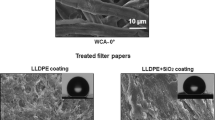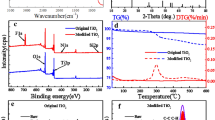Abstract
In order to solve the problem of blocking the filter media when bag filters are used to deal with high-humidity dust, hydrophobic surface-modified filter media were prepared. Here we constructed a multi-layer rough structure using TiO2 and SiO2, with polydimethylsiloxane (PDMS) subsequently deposited to reduce its surface energy to prepare stable and robust TiO2–SiO2@PDMS modified superhydrophobic filter media. Through modification of the filter media, its surface was changed from superhydrophilic to superhydrophobic, and the water contact angle reached 158°. For the particles with 0.3 μm, the filtration efficiency and quality factor of the modified filter media are higher than those of the unmodified filter media at a flow velocity of 0.043–0.127 m/s, which improves the filtration performance of the filter media. In addition, the modified filter media has strong durability in harsh environmental conditions (such as mechanical wear, strong acid or alkali solution), and has excellent self-cleaning performance. Therefore, such superhydrophobic filter media have great potential for the application of bag filters in various industrial production processes.

Graphical abstract
Highlights
-
Superhydrophobic filter media is prepared by TiO2–SiO2@PDMS coating.
-
The filtration efficiency and quality factor of the modified filter media are improved by 4.64% and 0.52% on average compared with the unmodified filter media.
-
The filter media modified by TiO2–SiO2@PDMS has excellent stability and self-cleaning performance.














Similar content being viewed by others
References
Gu GQ, Han CB, Lu CX et al. (2017) Triboelectric nanogenerator enhanced nanofiber air filters for efficient particulate matter removal. Acs Nano 11(6):6211–6217. https://doi.org/10.1021/acsnano.7b02321
Henning F, Fuks K, Moebus S et al. (2014) Association between source-specific particulate matter air pollution and hs-CRP: local traffic and industrial emissions. Environ Health Persp 122(7):703. https://doi.org/10.1289/ehp.1307081
Ancelet T, Davy PK, Trompetter WJ et al. (2014) Sources of particulate matter pollution in a small New Zealand city. Atmos Pollut Res 5(4):572–580. https://doi.org/10.5094/APR.2014.066
Lee S, Cho AR, Park D et al. (2019) Reusable polybenzimidazole nanofiber membrane filter for highly breathable PM2.5 dust proof mask. ACS Appl Mater Inter 11(3):2750–2757. https://doi.org/10.1021/acsami.8b19741.s001
Gao SW, Dong XL, Huang JY et al. (2018) Rational construction of highly transparent superhydrophobic coatings based on a non-particle, fluorine-free and water-rich system for versatile oil-water separation. Chem Eng J 333::621–629. https://doi.org/10.1016/j.cej.2017.10.006
Nurnadia A, Rashid M, Hajar S et al. (2015) Effect of filter aids on pressure drop and permeability of two different filter media. Adv Mater 1125:245–249. https://doi.org/10.4028/AMR.1125.245
Simon X, Chazelet S, Thomas D et al. (2007) Experimental study of pulse-jet cleaning of bag filters supported by rigid rings. Powder Technol 172(2):67–81. https://doi.org/10.1016/j.powtec.2006.10.005
Momen G, Farzaneh M (2012) A ZnO-based nanocomposite coating with ultra water repellent properties. Appl Surf Sci 258(15):5723–5728. https://doi.org/10.1016/j.apsusc.2012.02.074
Liu MM, Li J, Hou YY et al. (2017) Inorganic adhesives for robust superwetting surfaces. ACS Nano 11(1):1113–1119. https://doi.org/10.1021/acsnano.6b08348
Jin ZP, Mei H, Pan LK et al. (2021) Superhydrophobic self-cleaning hierarchical micro-/nanocomposite coating with high corrosion resistance and durability. ACS Sustain Chem Eng 9:4111–4121. https://doi.org/10.1021/acssuschemeng.0c09059
Zhou YY, Ma YB, Qi CH et al. (2021) Superhydrophobic surface based on nano-engineering for enhancing the durability of anticorrosion. Surf Eng 37(3):288–298. https://doi.org/10.1080/02670844.2020.1776668
Wang S, Liu K, Yao X et al. (2015) Bioinspired surfaces with superwettability: new insight on theory, design, and applications. Chem Rev 115:8230–8293. https://doi.org/10.1021/cr400083y
Luo ZL, Li Y, Duan C et al. (2018) Fabrication of a superhydrophobic mesh based on PDMS/SiO2 nanoparticles/PVDF microparticles/KH-550 by one-step dip-coating method. Rsc Adv 8(29):16251–16259. https://doi.org/10.1039/C8RA03262A
Luo G, Jin Z, Dong Y et al. (2016) Preparation and performance enhancements of wear-resistant, transparent PU/SiO2 superhydrophobic coating. Surf Eng 34(2):139–149. https://doi.org/10.1080/02670844.2016.1236068
Kamegawa T, Shimizu Y, Yamashita H (2012) Superhydrophobic surfaces with photocatalytic self‐cleaning properties by nanocomposite coating of TiO2 and polytetrafluoroethylene. Adv Mater 24(27):3697–3700. https://doi.org/10.1002/adma.201201037
Dong W, Qian FP, Li Q, et al. (2021) Fabrication of superhydrophobic PET filter material with fluorinated SiO2 nanoparticles via simple sol–gel process. J Sol-gel Sci Techn, 98(31). https://doi.org/10.1007/s10971-021-05483-4.
Pratiwi1 N, Zulhadjri1, Arief S, et al. (2020) Self-cleaning material based on superhydrophobic coatings through an environmentally friendly sol–gel method. J Sol-gel Sci Techn, 96(3). https://doi.org/10.1007/s10971-020-05389-7.
Zhong H, Hu Y, Wang YH et al. (2017) TiO2/silane coupling agent composed of two layers structure: A super-hydrophilic self-cleaning coating applied in PV panels. Appl Energ 204:932–938. https://doi.org/10.1016/j.apenergy.2017.04.057
Zhao X, Li LX, Li BC et al. (2014) Durable superhydrophobic/superoleophilic PDMS sponges and their applications in selective oil absorption and in plugging oil leakages. J Mater Chem A 2:18281–18287. https://doi.org/10.1039/C4TA04406A
Yong JL, Chen F, Yang Q et al. (2013) Controllable adhesive superhydrophobic surfaces based on PDMS microwell arrays. Langmuir 29(10):3274–3279. https://doi.org/10.1021/la304492c
Yong JL, Yang Q, Chen F et al. (2014) Superhydrophobic PDMS surfaces with three-dimensional (3D) pattern-dependent controllable adhesion. Appl Surf Sci 288:579–583. https://doi.org/10.1016/j.apsusc.2013.10.076
Guan K (2005) Relationship between photocatalytic activity, hydrophilicity and self-cleaning effect of TiO2/SiO2 films. Surf Coat Tech 191(2-3):155–160. https://doi.org/10.1016/j.surfcoat.2004.02.022
Tobaldi DM, Tucci A, Škapin AS et al. (2010) Effects of SiO2 addition on TiO2 crystal structure and photocatalytic activity. J Eur Ceram Soc 30(12):2481–2490. https://doi.org/10.1016/j.jeurceramsoc.2010.05.014.
Guan K (2005) Relationship between photocatalytic activity, hydrophilicity and self-cleaning effect of TiO2/SiO2 films. Surf Coat Tech 191(2-3):155–160. https://doi.org/10.1016/j.surfcoat.2004.02.022.
Hu JP, Fang Z, Huang YF et al. (2020) Fabrication of superhydrophobic surfaces based on fluorosilane and TiO2/SiO2 nanocomposites. Surf Eng 37:1–7. https://doi.org/10.1080/02670844.2020.1730059
Viola I, Zacheo A, Arima V et al. (2012) The influence of polydimethylsiloxane curing ratio on capillary pressure in microfluidic devices. Appl Surf Sci 258(20):8032–8039. https://doi.org/10.1016/j.apsusc.2012.04.164
Li Q, Qian FP, Dong W et al. (2022) Preparation and properties of TiO2 superhydrophobic filter media modified by silane coupling agent KH570. J Mater Eng 50(2):144–152. https://doi.org/10.11868/j.issn.1001-4381.2021.000006
Wu YR, Shen HG, Chase GG (2016) Experimental study on the performance of fibrous media with the drain-age channels in gas-liquid coalescence filtration. J Saf Environ 16(003):289–293. https://doi.org/10.13637/j.issn.1009-6094.2016.03.057
Brown, RC (1993) Air filtration: An integrated approach to the theory and applications of fibrous filters. Oxford: Pergamon Press.
Mallakpour S, Barati A (2011) Efficient preparation of hybrid nanocomposite coatings based on poly(vinyl alcohol) and silane coupling agent modified TiO2 nanoparticles. Prog Org Coat 71(4):391–398. https://doi.org/10.1016/j.porgcoat.2011.04.010
Su X, Shi BL (2016) Effect of silane coupling agents with different non-hydrolytic groups on tensile modulus of composite PDMS crosslinked membranes. React Funct Polym 98:1–8. https://doi.org/10.1016/j.reactfunctpolym.2015.11.001
Deng ZY, Wang W, Mao LH et al. (2014) Versatile superhydrophobic and photocatalytic films generated from TiO2–SiO2@PDMS and their applications on fabrics. J Mater Chem A 2(12):4178–4184. https://doi.org/10.1039/C3TA14942K
Wooh S, Encinas N, Vollmer D et al. (2017) Stable hydrophobic metal-oxide photocatalysts via grafting polydimethylsiloxane brush. Adv Mater 29(16):1604637. https://doi.org/10.1002/adma.201604637
Krumpfer JW, Mccarthy TJ (2011) Rediscovering silicones: “unreactive” silicones react with inorganic surfaces. Langmuir 27(18):11514–11519. https://doi.org/10.1021/la202583w
Peng S, Meng WH, Guo JX et al. (2019) Photocatalytically stable superhydrophobic and translucent coatings generated from PDMS-Grafted-SiO2/TiO2@PDMS with multiple applications. Langmuir 35(7):2760–2771. https://doi.org/10.1021/acs.langmuir.8b04247.s001
Ding YY, Xu B, Ge FY et al. (2015) Robust superhydrophobic and photocatalytic cotton fabrics based on TiO2–SiO2-PDMS composite coating. KEM 671:225–230. https://doi.org/10.4028/www.scientific.net/kem.671.225
Kapridaki C, Maravelaki-Kalaitzaki P (2013) TiO2–SiO2–PDMS nano-composite hydrophobic coating with self-cleaning properties for marble protection. Prog Org Coat 76(2–3):400–410. https://doi.org/10.1016/j.porgcoat.2012.10.006
Yang MP, Liu WQ, Jiang C et al. (2018) Fabrication of superhydrophobic cotton fabric with fluorinated TiO2 sol by a green and one-step sol-gel process. Carbohyd Polym 197:75–82. https://doi.org/10.1016/j.carbpol.2018.05.075
Majoul N, Aouida S, Bessaïs B (2015) Progress of porous silicon APTES-functionalization by FTIR investigations. Appl Surf Sci 331:388–391. https://doi.org/10.1016/j.apsusc.2015.01.107
Chen Q, Nikolai LYakovlev (2010) Adsorption and interaction of organosilanes on TiO2 nanoparticles. Appl Surf Sci 257(5):1395–1400. https://doi.org/10.1016/j.apsusc.2010.08.036
Cao BW, Wang SL, Dong W et al. (2020) Investigation of the filtration performance for fibrous media: Coupling of a semi-analytical model with CFD on Voronoi-based microstructure. Sep Purif Technol 251:117364. https://doi.org/10.1016/j.seppur.2020.117364
Xing Y, Cui YK, Su W et al. (2020) Study on the mechanism of ultrafine particles removal by SBA-15. Chin J Eng 42(03):313–320. https://doi.org/10.13374/j.issn2095-9389.2019.04.01.004
Guo ZF, Guo F, Wen QY et al. (2017) Simple one-pot approach toward robust and boiling-water resistant superhydrophobic cotton fabric and the application in oil/water separation. J Mater Chem A 5(41):21866–21874. https://doi.org/10.1039/C7TA05599D
Xie J, Hu J, Lin XD et al. (2018) Robust and anti-corrosive PDMS/SiO2 superhydrophobic coatings fabricated on magnesium alloys with different-sized SiO2 nanoparticles. Appl Surf Sci 457:70–880. https://doi.org/10.1016/j.apsusc.2018.06.250
Cao CY, Ge MZ, Huang JY et al. (2016) Robust fluorine-free superhydrophobic PDMS – ormosil @ fabrics for highly effective self-cleaning and efficient oil-water separation. J Mater Chem A 4(31):12179–12187. https://doi.org/10.1039/C6TA04420D
Lai YK, Tang YX, Gong JJ et al. (2012) Transparent superhydrophobic/superhydrophilic TiO2-based coatings for self-cleaning and anti-fogging. J Mater Chem 22:7420–7426. https://doi.org/10.1039/C2JM16298A
Afzal S, Daoud WA, Langford SJ (2014) Superhydrophobic and photocatalytic self-cleaning cotton. J Mater Chem A 2(42):18005–18011. https://doi.org/10.1039/C4TA02764G
Acknowledgements
This study was financially supported by Anhui Provincial Scientific and Technological Major Project (Grant no. 18030801109).
Author contribution
Credit author statement. QL: Conceptualization, Methodology, Validation, Investigation, Writing – original draft, Reviewing and Editing. FQ: Supervision, Resources, Funding acquisition, Project administration. KY: Investigation. WD: Formal analysis, Investigation. YH: Investigation, Resources. JL: Investigation, Resources.
Author information
Authors and Affiliations
Corresponding author
Ethics declarations
Conflict of interest
The authors declare no competing interests.
Additional information
Publisher’s note Springer Nature remains neutral with regard to jurisdictional claims in published maps and institutional affiliations.
Rights and permissions
About this article
Cite this article
Li, Q., Qian, F., Yuan, K. et al. Properties of superhydrophobic filter media prepared by TiO2–SiO2@PDMS coating. J Sol-Gel Sci Technol 107, 178–189 (2023). https://doi.org/10.1007/s10971-022-05871-4
Received:
Accepted:
Published:
Issue Date:
DOI: https://doi.org/10.1007/s10971-022-05871-4




